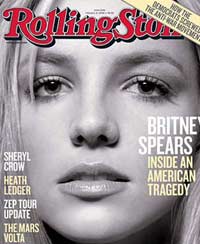 Last weekend I was encouraged to see the New York Times article “Boys Will Be Boys, Girls Will Be Hounded,” which poses the possibility of a double standard in the way the press persecutes girl-celebrities like Britney Spears and Lindsay Lohan while gently letting the falls and tragedies of their male counterparts (think Owen Wilson, Heath Ledger) remain low-key “out of respect” for the stars and their loved ones. Reporter Alex Williams reflects:
Last weekend I was encouraged to see the New York Times article “Boys Will Be Boys, Girls Will Be Hounded,” which poses the possibility of a double standard in the way the press persecutes girl-celebrities like Britney Spears and Lindsay Lohan while gently letting the falls and tragedies of their male counterparts (think Owen Wilson, Heath Ledger) remain low-key “out of respect” for the stars and their loved ones. Reporter Alex Williams reflects:
“Men who fall from grace are treated with gravity and distance, while women in similar circumstances are objects of derision, titillation and black comedy. Some celebrities and their handlers are now saying straight out that the news media have a double standard.”
You think?
Each month, Idol Chatter reaps the benefits that come from the posts by my fellow bloggers that write up, judge, and reflect on the latest trials and public falls of the likes of the girl-celebrity-trifecta: Paris, Britney, and Lindsay (and occasionally others). These posts tend to receive an enormous amount of hits—as similar posts do on all sorts of other blogs on the web.
You will never see my byline after one of these posts, however. In principle, I refuse to contribute to what is a veritable industry entirely dedicated to chronicling the ups and downs of these young women since the time they were mere girls—without seeming to worry much about whether all this coverage is truly destroying them in the process. You can say all you want about the public’s right to follow their lives since these women are public figures, you can say that it’s their own fault, that they bring it on themselves, that they’re rich beyond our wildest dreams, but I don’t care. These young women are man-made (literally) from the time there are teenagers by publicity companies and record companies and the press that cover them into playthings for public consumption and public derision—a public so addicted to following celebrity that when these women fall, people can’t get enough of seeing their tragically wounded selves.
When we fall—as we all do—most of us face only dusting ourselves off and repairing in front of family and sometimes more publicly in front of friends and even acquaintances. But these celebrity women do not enjoy this possibility. They fall to pieces and the press and a voraciously hungry public stomp up and down gleefully on the pieces that are all these girls have left, and do so complete with color commentary.
How in the world can we keep justifying this kind of behavior?
Now the cover story of the February 21 issue of Rolling Stone features a close-up of Britney Spears beautiful face and the headline: “Britney Spears: Inside an American Tragedy.” It seems as if Rolling Stone might repent of their own role in the public destruction of the sweet pop star girl that Britney Spears once was. Open to the article, however, and you meet another close-up of a tear-stained Britney, mid-sob, paired with a virtual photo-slideshow of her life and breakdowns, and more than a fair share of ambiguous reporting. The article slams the media “machine” that created Britney Spears and subsequently, has almost killed her with their refusal to relent and leave her be to pick up the pieces:
“She was created a virgin to be deflowered before us, for our amusement and titillation….More than any other star today, Britney epitomizes the crucible of fame for the famous: loving it, hating it and never quite being able to stop it from destroying you.”
Yet at the same time the article slams Britney for not being strong enough and mature enough to get out from under the machine on her own. Somehow this is all still Britney’s fault that she can’t better weather the 24-7 paparazzi in cars, on foot, even in helicopters trailing her every move since she was 16, but now more than ever since she’s begun to crack and crumble.
This week’s questioning of whether maybe, just maybe, it’s not all “their fault”—the Britneys, Parises, and Lindsays of celebrity—is occurring alongside Lindsay Lohan’s “comeback” nude photo essay in New York Magazine. The essay mimics another which was also Marilyn Monroe’s last before her drug-induced death. The New York Times also fretted over Lohan’s decision to do this, given that the photos offer a rather “macabre” implication about where she is potentially headed (given where Marilyn went), rather than offering readers a Lindsay Lohan now-empowered, taking-control, post-rehab kind of feeling.
Seeing this issue of New York Magazine on the stands made me incredibly sad. We are a public that celebrates younger and younger women falling from grace, that teaches girls to embrace the seedier side of their sexual selves by tricking them into thinking it’s empowering, that gets off on every little move—whether toward “redemption” or toward more “sin”—that these girls make and then sits in happy judgment about it all. I am sickened by it.
I think it’s time we take a good long look at ourselves and question our own ethics in this mess of a girl-tragedy-celebrity culture, how perhaps we, ourselves, are willing participants in their destruction. I can’t help but find it troubling that even a website dedicated to reflection on a diversity of faiths and spiritualities, a site for which I love writing, also participates in this destructive culture of celebrity voyeurism.
Whether or not the tide is turning and the press is beginning to feel a little guilty about its own role in these celebrities’ troubles—particularly that of celebrity girls and young women—is debatable. But this is both the first and last time you will see me commenting about it.


